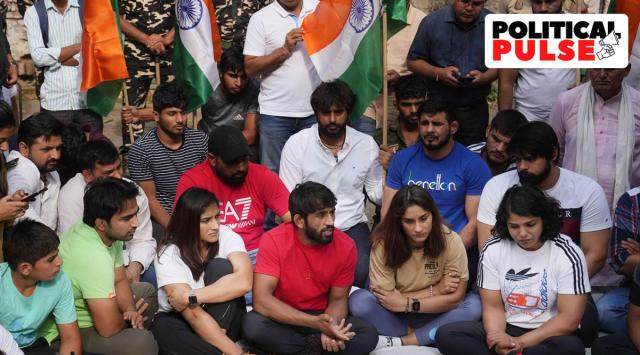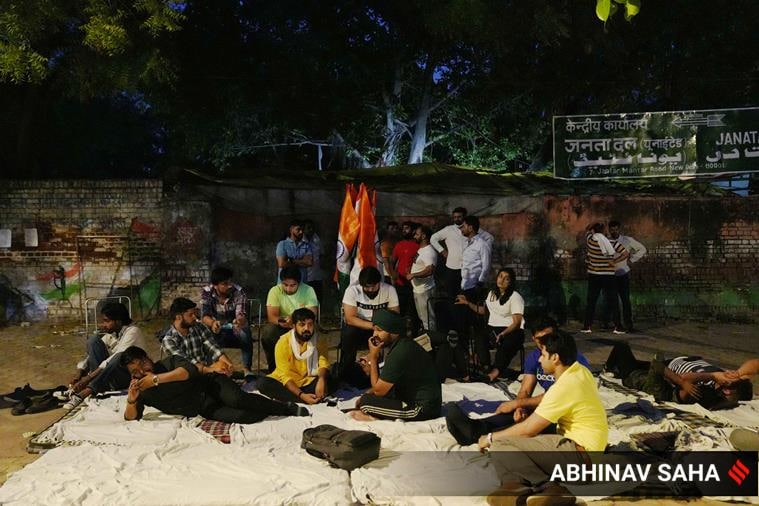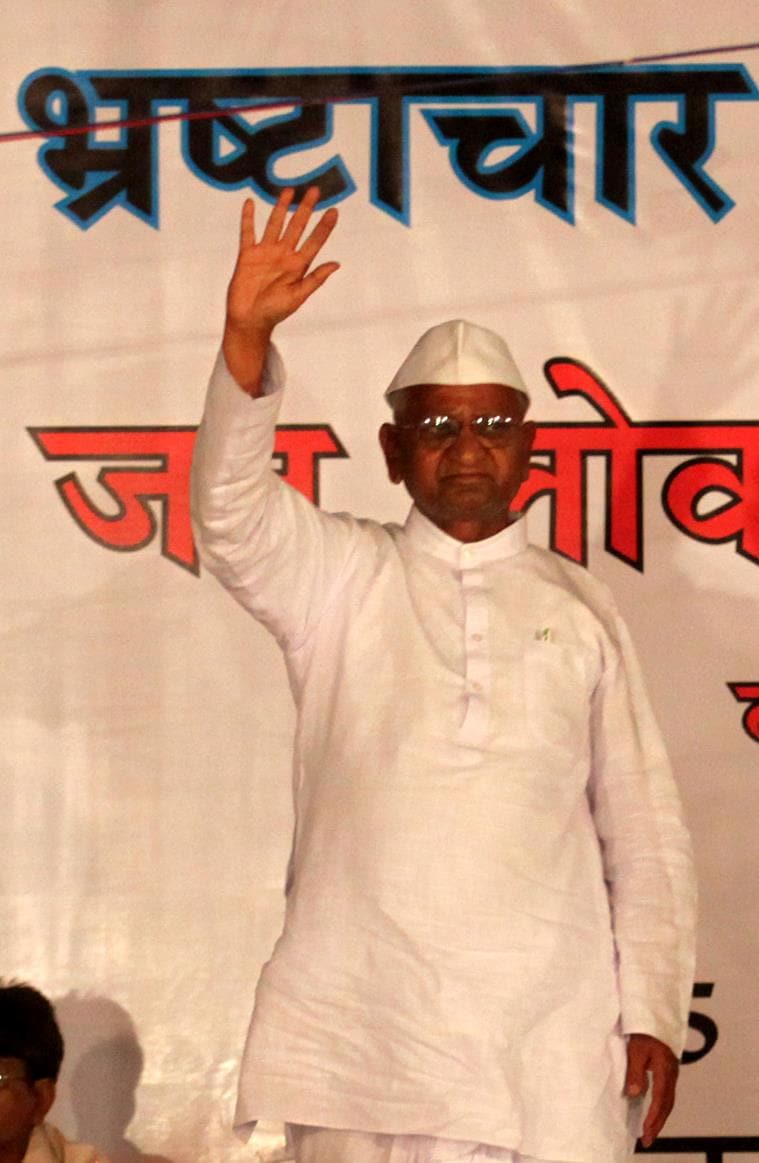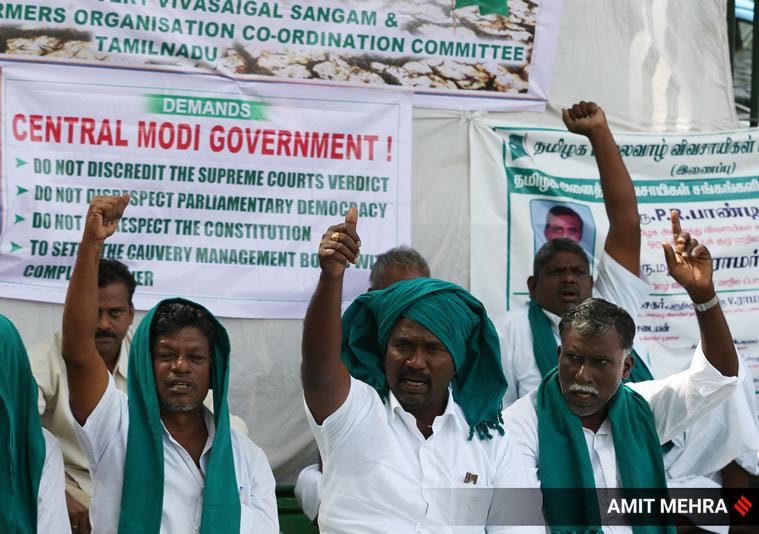Wrestlers latest in 30-year history of Delhi’s dissent square — Jantar Mantar
Earlier, when Delhi was still to expand its boundaries, it was the Boat Club that was the space for resistance. But with Ram temple movement raging, the Congress government, rattled by a 1988 agitation, imposed a ban on gatherings at the Boat Club.
 Some of India's top wrestlers, including Sakshi Malik, Vinesh Phogat and Bajrang Punia, are demanding action against WFI chief Brij Bhushan Sharan Singh at an ongoing protest at Delhi's Jantar Mantar. (Express file photo by Abhinav Saha)
Some of India's top wrestlers, including Sakshi Malik, Vinesh Phogat and Bajrang Punia, are demanding action against WFI chief Brij Bhushan Sharan Singh at an ongoing protest at Delhi's Jantar Mantar. (Express file photo by Abhinav Saha) The protest by India’s top wrestlers against Wrestling Federation of India (WFI) chief Brij Bhushan Sharan Singh entered its 16th day on Monday. Some farmers’ groups trying to enter Delhi to join the wrestlers’ protest were stopped by the Delhi Police at the Tikri Border on Sunday.
The wide footpath or lane abutting Jantar Mantar, the 18th-century observatory, has become synonymous with protests of all kinds over the years. During the course of this protest too, the wrestlers’ made it their home to demand action against Singh. On Friday, they formed two committees to advice them on the future course of action in their fight against the outgoing WFI chief. The physical proximity of the site to Parliament — less than 2 km away — is also crucial to its relevance.
 Wrestlers Sangeeta Phogat, Bajrang Punia, Vinesh Phogat, Sakshi Malik have said that they will stay at Jantar Mantar until their demands get fulfilled. (Express file photo by Abhinav Saha)
Wrestlers Sangeeta Phogat, Bajrang Punia, Vinesh Phogat, Sakshi Malik have said that they will stay at Jantar Mantar until their demands get fulfilled. (Express file photo by Abhinav Saha)
The story of Jantar Mantar as a protest site began in 1993. There was no ordinance, no official declaration, yet the tree-lined boulevard that connects Tolstoy Road to the Ashoka Road roundabout came to be the only place in New Delhi where Section 144 — the 19th-Century British-era law that prohibits the assembly of more than five people — was not imposed. That year, the capital got its new dissent square — Jantar Mantar.
Until then, at a time when Delhi was still to expand its boundaries southwards and eastwards, it was the Boat Club, with its view of Janpath, Rajpath and Parliament, that was the iconic space for resistance. But with the Ram Janmabhoomi-Babri Masjid movement gripping the country, the Congress-led government, already rattled by an earlier agitation in 1988 led by western Uttar Pradesh farm leader Mahendra Singh Tikait., imposed a ban on gatherings at the Boat Club.
But after that, it became apparent to successive governments that the protest venue had to be controlled. Jantar Mantar seemed ideal at the time. Though it was close to Parliament, it was not large enough to hold a big crowd. Besides, the topography of Jantar Mantar, with its two main entry and exit points, was easier to manage.
In October 2018, the National Green Tribunal (NGT) appealed to the SC to ban protests at Jantar Mantar after some residents of the area argued that they had to put up with noise pollution and unhygienic surroundings. The NGT found merit in their plea and asked authorities to shift the protesters to an alternative site — Ramlila Maidan, about 4 km away. The tribunal cited three grounds while issuing these directions — there is no executive order that demarcates Jantar Mantar as a ‘protest site’, that it’s marked as a ‘residential area’ in the Delhi Master Plan and finally, that the agitations caused noise pollution.
However, in July 2018, the SC ruled against a total ban on protests in the Jantar Mantar and Boat Club area, subject to regulations regarding the manner in which they are organised and the number of people attending the protests.
 Social activist Anna Hazare at an anti-corruption protest at Jantar Mantar in 2011. (Express archive photo by Ravi Kanojia)
Social activist Anna Hazare at an anti-corruption protest at Jantar Mantar in 2011. (Express archive photo by Ravi Kanojia)
One of the most significant protests at the venue in the recent past were on April 5, 2011, when Anna Hazare, then a relatively unknown social activist from Maharashtra, began a hunger strike at Jantar Mantar to root out corruption and to demand a Lokpal Bill. The movement snowballed, with prominent activists such as Prashant Bhushan and Arvind Kejriwal joining in, finally leading to the birth of the Aam Aadmi Party (AAP).
The venue has been the site of various other landmark political protests.
 Arvind Kejriwal, Baba Ramdev, Anna Hazare and Manish Sisodia at a protest site in Jantar Mantar in 2012. (Express archive)
Arvind Kejriwal, Baba Ramdev, Anna Hazare and Manish Sisodia at a protest site in Jantar Mantar in 2012. (Express archive)
Between March and April 2017, debt-ridden farmers from Tamil Nadu held an agitation in the national capital for 40 days and demanded a Rs 40,000-crore drought relief package, debt waiver and setting up of the Cauvery Management Board by the Centre. They carried out dramatic protests, including using skulls, holding dead rats in their mouths to indicate that they will be forced to eat rodents if the situation worsens, and even threatening to slit their throats if their demands weren’t met.
 In 2018, farmers from Tamil Nadu protested in demand of the constitution of Cauvery Management Board. (Express file photo by Amit Mehra)
In 2018, farmers from Tamil Nadu protested in demand of the constitution of Cauvery Management Board. (Express file photo by Amit Mehra)
They suspended their protest on April 25 that year when CM Eppadi K Palaniswami met the farmers and promised to take up the issue with the Prime Minister. He also maintained that his government had discussed the issue with Finance Minister Arun Jaitley and Home Minister Rajnath Singh. Later in the day, Palaniswami met PM Narendra Modi on the sidelines of the NITI Aayog governing council meeting. By the end of the day, the farmers announced suspension of the agitation.
On August 6, 2019, students from some city colleges along with activists gathered at Jantar Mantar in the afternoon to protest the abrogation of Article 370 in Jammu and Kashmir by the central government.
Addressing the gathering, All India Progressive Women’s Association secretary Kavita Krishnan said: “The Delhi government wants that Delhi’s status be changed to full statehood. If one night, the Central government comes and makes Delhi a part of Haryana, they will say that it is a violation of federalism. But does the principle of federalism not apply to Kashmir?”
 Anti CAA-NRC protests at Jantar Mantar in 2020. (Express file photo by Prem Nath Pandey)
Anti CAA-NRC protests at Jantar Mantar in 2020. (Express file photo by Prem Nath Pandey)
On December 19 2019, a massive crowd gathered to protest against the Citizenship Amendment Act (CAA). Lawyers participating in the demonstration offered legal assistance to protestors in case they were detained by the Delhi Police. The protestors, including students and activists, gathered at Jantar Mantar after they were not allowed to hold demonstrations near the Red Fort and Mandi House, where prohibitory orders had been imposed. A human chain was formed at both Jantar Mantar and Red Fort to make space for Muslim protesters to offer ‘namaaz’.
On March 13 this year, at the start of the second part of Parliament’s budget session on March 13, five farmer unions from Punjab staged a protest against the Union government at Jantar Mantar over issues of CBI searches at properties of farmers’ leaders and long-standing demands on loan waivers and Minimum Support Price (MSP).
Farmers earlier took part in a procession from the Gurudwara Shri Bangla Sahib in the city while carrying flags and placards.
The protest site was also witness to protests against the death of 19-year-old Arunachali student Nido Tania in 2014; the justice for Nirbhaya campaign in 2012, among others.
- 01
- 02
- 03
- 04
- 05































